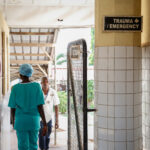- South Africa’s HIV action plans don’t take into account how climate change-related extreme weather events will affect those living with the virus.
- One man in Durban, for instance, missed a dose of HIV treatment for the first time as a direct result of the KZN floods. The nonprofit that usually helps him out was closed for two weeks.
- The World Bank launched a new fund to help 20 countries in Asia, Africa and the Middle East recover from climate crises, but South Africa won’t benefit from it — and experts say the country’s disaster management policies are rolled out badly.
Mfundo Shezi, 32, has been living on the streets of Durban for 16 years.
He sleeps in a park in Umbilo, a suburb in the middle of town, every evening. On the night of 12 April, he was woken up by rains so heavy that he didn’t even think to gather his possessions; he just ran for shelter.
The next morning, still drenched, he returned to the place where he keeps his things to find that all his belongings were gone, washed away by one of the worst floods to hit South Africa since 1987. Some places had had more than 300mm of rain in 24 hours — that’s about a third of the amount of rain KwaZulu-Natal usually gets in a year.
He looked around the flooded park for ages, becoming more panicked as the day dragged on because he couldn’t find two things: his identity document (ID) and a month’s supply of antiretroviral (ARV) treatment for HIV.
Shezi has been taking ARVs since 2021. Nervously wringing a black beanie between his hands, he says: “On that day, I missed a dose for the first time.”
A fund to help people recover from climate crisis disasters
A rainstorm as severe as the one that caused the KwaZulu-Natal floods in April could happen twice as often as about 150 years ago, when the atmosphere’s average temperature was 1.2 degrees Celsius lower than it is now, found scientists at the World Weather Attribution Service.
It’s this type of extreme weather that state leaders are working to make plans to keep at bay. For the past 12 days they’ve been gathering in the Egyptian city of Sharm El-Sheikh for the 27th United Nations Climate Change Conference (COP 27), which ends on Friday.
In a huge win for Africa — which will bear the brunt of a worsening climate crisis — a World Bank climate fund called the Global Shield Financing Facility was launched at COP 27 to help poorer countries cope with the “loss and damage” caused by bad weather events.
Loss and damage describes the irreversible harms extreme weather events cause to human life. It covers both economic impacts (an industry such as forestry might be affected negatively by fires, for example) and the emotional cost of losing family members or being forced to move from one’s home.
Who will benefit from this fund? A group of 20 countries in Africa, Asia and the Middle East that climate change will hit the hardest. South Africa is not part of this group.
In the meantime, KwaZulu-Natal’s April floods left 448 people dead and more than 8 500 homes destroyed. Road agencies identified 1 300 repair projects and the Treasury made R1-billion available to help rebuild infrastructure in the province, but the South African Human Rights Commission told parliament that health services were inadequate during the disaster period.
No ID book, no HIV meds & nowhere to turn
Shezi panicked. He needed a new batch of HIV medicine, but couldn’t get to the clinic where he usually picks up his pills.
The following day, he walked to a government hospital in the area that was still open, hoping they’d be able to help him.
But no luck, because he didn’t have his ID book. Administrators at public health facilities need this document to open a file for people who aren’t already in their system, or a transfer letter from a previous facility, which he didn’t have either.
When people with HIV aren’t on treatment, the virus can multiply in their blood, which makes it harder for their bodies to fight off infections.
Research published in the journal Global Health Action in 2015 suggests that floods like these may put HIV-positive people such as Shezi in an especially difficult position.
From interviews with people affected by floods that happen often in the poor, rural Ohangwena region of northern Namibia — an area where up to one in six people between 25 and 49 years were HIV positive at the time of the study — researchers found that floods disrupt people’s daily routines (for example, how often they eat) and they may not have access to clean water, which could make illnesses such as diarrhoea more common.

Diarrhoea is a condition that causes watery stools and can let the body become severely dehydrated, and this could be fatal.
Because HIV weakens the immune system, people living with the virus are prone to developing long-lasting diarrhoea if they’re infected by germs such as those that cause cholera (a bacterial disease that results in diarrhoea) when they drink unsafe water.
The chances of people becoming infected with HIV also go up in the aftermath of a flood, the researchers found. That’s because projects that distribute condoms and other contraceptives may be disrupted and people may also find themselves in unsafe situations.
One aid worker’s response was especially harrowing: “People are getting infected with HIV during flooding because they are raped. The environment is not conducive, there are no lights in the relocation camps and people have to walk long distances.”
In Durban, try as he might, Shezi could not get a new batch of ARVs. Missing just one day of HIV treatment could give the virus enough opportunity to multiply in people’s bodies and start weakening their immune system, says the Southern African HIV Clinicians Society. It would be another two weeks before Shezi got a refill.
The HIV patients who never came back for treatment
On a rainy October day in Umbilo, the same area where Shezi lives, people are lining up outside the nonprofit centre TB HIV Care.
Every couple of minutes, Leoness Meth, a nurse, emerges from the facility to call the next patient.
Many of them are there to collect methadone, a drug used as part of opioid substitution therapy. The treatment helps people who inject drugs to cope with withdrawal when they stop using the drugs, but methadone doesn’t result in a high. It’s part of South Africa’s national HIV and TB plan because it reduces new HIV infections among people who use drugs as they are less likely to share needles to get their fix.
People can also get tested for HIV at the centre, talk to counsellors or pick up HIV medication here.
However, after the floods, says Meth, they closed for two weeks, because staff couldn’t get to work owing to roads being inaccessible and it not being clear when the heavy rains would subside.
When the centre reopened in early May, about a quarter of the 40 people who got ARVs from the centre hadn’t returned.
“Some people thought [TB HIV Care, which provides the medicine] was closed permanently and a few moved to different areas [because of the floods],” Meth says.
When people stop their treatment, there’s a good chance that they might not collect it again — which could lead to their immune systems weakening (because of HIV starting to build up in their bodies again) and them becoming vulnerable to other diseases.
An analysis of nearly 22 650 people’s medical records in Ethiopia, for instance, found that only 35% of people who stopped taking their ARVs were back on treatment five years later, even if they stopped taking their pills for as little as a month.
A local study that tracked patients over five years showed similar results, but also that of the people who resumed their treatment (after about 10 months), nearly eight in ten would miss doses again in the future.
The floods destroyed bridges, roads & the plans that usually get HIV patients back into care
Bongiwe Sithole is staring at the rain from inside one of TB HIV Care’s offices. She’s a “linkage officer”, which means she helps people to manage their HIV treatment. She goes into communities to find people who don’t return for their medication, accompanies some to their appointments and sometimes collects pills on patients’ behalf.
It works well to help people stick to taking their HIV medicine. The health department’s guidelines for adherence also suggest using SMSes, phone calls and home visits for this.
Even in perfect conditions, people don’t always stick to their HIV treatment (this is sometimes called “defaulting”), but the floods changed the way community health workers like Sithole works.
She lives in a township bordering the Molweni River. It burst its banks during the storm and destroyed four bridges, which made her journey to work longer — and more dangerous.
She now has to wake up an hour earlier and leave the house in darkness (around 4am) to get to work on time. She only gets back once it’s dark again.
Sithole explains: “Sometimes there will be no one [in the streets], so you have to walk alone. And because it’s dark and there are no streetlights, you get scared.”
The higher river levels also likely stopped some of Sithole’s patients from coming to the clinic to get their treatment.
In the Namibian research, one aid worker said: “Crossing the water is dangerous, so you sometimes don’t want to do that. Some [people living with HIV] have defaulted their service, they [aren’t] coming to get their ARV treatment for fear or phobia of water.”
How to keep people on HIV treatment during floods
Collins Iwuji, a researcher from the African Health Research Institute, says South Africa’s disaster management policies lack concrete plans to keep HIV services going during disasters such as floods and droughts.
The problem is not so much with what these strategies say on paper, but rather with what really happens during a crisis.
Iwuji says it’s usually up to government departments to roll out relief efforts, but they don’t communicate with one another — and that’s how people like Shezi fall through the cracks.
For example, the South African Weather Service alerted people that heavy rains were coming, he says, but then not enough was done to help people prepare for it.
The municipal disaster response team is normally responsible for making sure people are prepared before and after disasters like a flood, according to the Disaster Management Act.
But the national cooperative governance and traditional affairs department (Cogta) handled the April floods because it was declared a national state of disaster. A Cogta presentation shows that water was sent to damaged health facilities, search and rescue teams were deployed and mobile classrooms were installed.
Not enough was, however, done to warn people (especially in the rural areas) to help them cushion the blow of the event, says Iwuji.
In Namibia, though, disaster relief teams have figured out a way to help to keep people on HIV treatment.
When it looks like flooding is about to start, facilities will begin to hand out six months’ worth of HIV treatment. Health workers will remind their patients to collect more medication and nonprofits and home-based care organisations explain to people what to expect during floods and how they can stay safe and healthy.
The health department in Namibia has also set up a special registry for ARVs during the floods to try and keep track of patients receiving their treatment and, if they are located too far away, move them closer to healthcare centres. Health information is also broadcast on the radio and at places where people gather such as schools and churches.
It’s not a perfect solution as some people are still unable to get their medication, but it helps, the study shows. And researchers say an approach like Namibia’s is a better way to prevent people from stopping their treatment during floods than the ill-prepared response of South Africa’s public health sector.
Research shows countries who have HIV policies that include plans for dealing with issues brought on by climate change are better equipped to deal with such crises — South Africa’s HIV and TB plan, which lapses at the end of the year, doesn’t include such guidelines. It’s not yet clear what the new plan will look like and the South African National Aids Council did not respond to Bhekisisa’s questions regarding the plan.
Back in Umbilo, Shezi is worried about how a future disaster like the April floods might affect him. “I was spinning [during the flood]. I didn’t want to think or cope with the stress.”
But he hopes that he can get himself out of his situation and off the streets.
“I’m praying that God must find me some better place to stay.”
Zano Kunene is a health journalist at Bhekisisa.







